What Is Kolam and Why Is It More Than Just Traditional Floor Art?
Every morning, before the first rays of sunlight touch the earth, Tamil Nadu comes alive with a ritual both timeless and unique. Women step outside, sweep the entrance of their homes, sprinkle water, and set to work creating beautiful patterns on the ground. These designs, known as Kolam, adorn thresholds, courtyards, and streets, bringing a touch of charm and cultural pride to everyday life.
Formed with dots, loops, and lines, the Kolam reflects Tamil Nadu’s heritage. Drawn using rice flour, it symbolizes auspiciousness and prosperity while also serving as an offering for birds and insects. Though rooted in Tamil culture, This art form finds its place in the traditions of neighboring states like Andhra Pradesh, Karnataka, and Kerala.
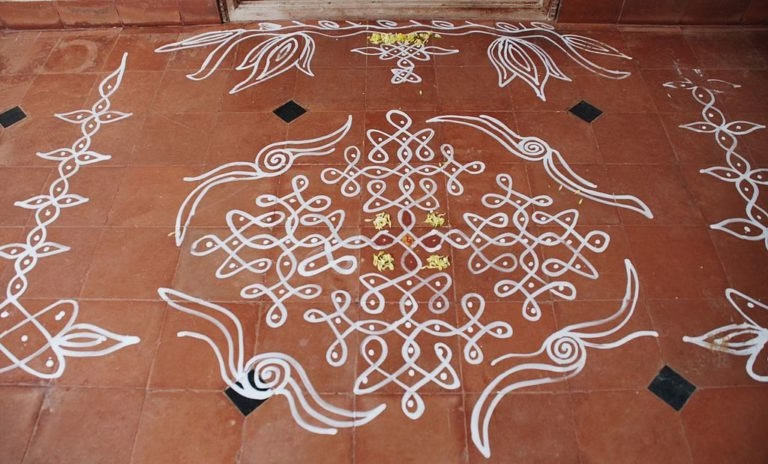
The process is as graceful as the designs themselves. With steady hands, women let rice powder flow between their fingers, creating patterns in one continuous motion. These designs can be simple or complex, often featuring shapes inspired by nature, birds, animals, or celestial forms. The precision of the patterns has even intrigued researchers, who study their mathematical intricacies.
More than just a decoration, the art work is a welcoming symbol. It invites the blessings of Goddess Lakshmi, believed to bring fortune and prosperity, while keeping away her less-favored sister, Mudevi. Drawing a Kolam is a prayer in itself, an offering of care and gratitude, and a marker of well-being for the household.
Every morning, this art transforms the ordinary into the extraordinary, a tradition that continues to thrive, connecting generations and keeping Tamil Nadu’s cultural essence alive.
How Did Kolam Originate, and What Does It Represent?
The artistic tradition of this art form has its roots steeped in history, dating back over two millennia. This ancient practice is vividly captured in classical Tamil literature, particularly in renowned works like the “Silappadikaram” and “Manimekalai,” where it is celebrated as a significant cultural expression. Scholars suggest that this art form originated as complicated threshold designs, carefully crafted to delineate the sacred space of the home from the outside world.
The origins of the kōlam tradition remain somewhat unclear and elusive. According to Professor Gift Siromoney from Madras Christian College, there is no direct mention of the this art work in Tamil word lists (Nigandus), classical Tamil literature, ancient paintings, or records from travelers. In his article published in Kalakshetra Quarterly, Siromoney suggests that the common floor patterns associated with kōlam may not be as ancient as often believed. He argues that the practice of decorating the floor likely dates back around 600 years, with some designs possibly influenced by Jain temples in South Kanara and Mahayana Buddhist traditions.
The first use of the term “kōlam” to describe floor patterns appears in two Tamil literary works: Madurai Meenatchiammai Kuram (a 16th-century Kuravanji) and Kutrala Kuravanji (from the 17th century). These works mark the earliest recorded instances of the term, though they focus more on the concept of floor decorations rather than the specific designs we recognize today. While the word “kōlam” itself appears in early Tamil literature, its references typically point to meanings like disguise, play, beauty, and form rather than to the floor patterns themselves.
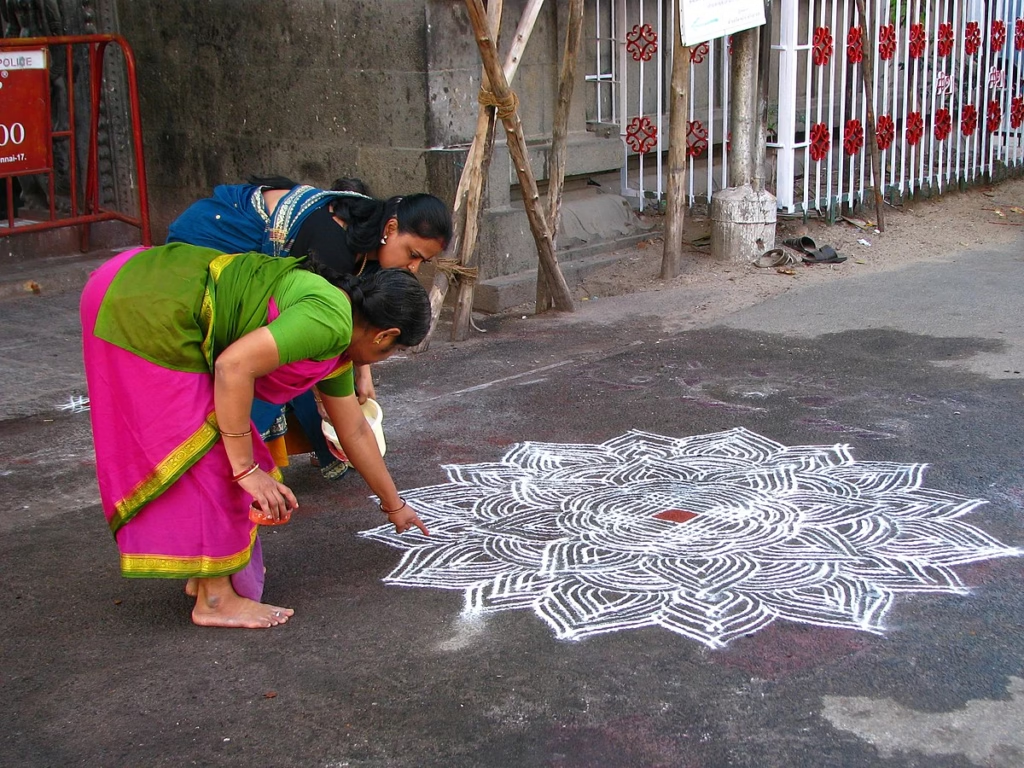
However, Siromoney acknowledges that some geometric designs used in kōlams, such as yantras or Tantric symbols, can be traced back to ancient times. In her book The Ritual Arts of India, Stella Kramrisch references early Vedic texts that describe the drawing of sun-like patterns on the ground, hinting at the ancient origins of the it’s tradition.
Though early Tamil literature, such as the Tiruppāvai (a sacred poetic work by Āntāl) and Tirumoli by Nācciyār, contains the term “mandala,” it refers more broadly to ritual art, particularly in front of homes. These texts don’t describe the exact practice of kōlam as we know it today but suggest a cultural connection to women’s ritual arts.
The earliest written records specifically referencing the word “kōlam” come from a 13th-century inscription in Tirunelveli, which mentions temple women tasked with cleaning and decorating temple floors with these designs. Another reference is found in the 17th-century Sanskrit text Strīdharmapaddhati by Tryambakayajvan, which emphasizes that the thresholds of homes should not be left bare. Instead, they should be adorned with ritual designs, typically created by the woman of the house or a servant. These references help illuminate the evolving role of this art form in both domestic and religious settings over time.
While the exact origins remain open to interpretation, it is clear that this tradition has roots stretching back centuries, blending various cultural and spiritual influences to become the vibrant, meaningful practice we recognize today.
What Philosophies and Symbolism Are Embedded in Kolam Patterns?
Philosophy behind it
While Kolam is widely celebrated as a traditional form of floor art, its beauty goes far beyond the patterns drawn on the ground. It carries a deeper meaning, reflecting values and principles that resonate with life itself. Here’s a look at the philosophies woven into this timeless tradition:
- Life’s Impermanence:
The fleeting nature of a Kolam, drawn with rice flour or powder and destined to fade with time, mirrors life’s transient beauty. It reminds us to cherish the present moment, knowing that everything we hold dear is temporary yet meaningful. - Everything is Connected:
The interconnected patterns of a Kolam are a quiet reflection of the unity in the universe. Each line flows into the next, symbolizing how all things—our actions, choices, and relationships—are deeply intertwined, forming a larger cosmic balance.

- Mindfulness in Motion:
Drawing a Kolam is not just about creating a design; it’s an act of mindfulness. With each curve and stroke, there’s a need for focus and presence. The process becomes a meditative practice, grounding the artist in the moment and offering a sense of calm and clarity. - Finding Balance in Life:
The symmetry speaks to the importance of balance. It’s a gentle nudge to seek harmony—between work and rest, self and others, and the physical and spiritual aspects of life. These patterns remind us that a balanced life is a fulfilling one. - Creativity and Self-Expression:
Some keep it simple, while others bring it to life with color and flair, like the vibrant Rangoli in Maharashtra or the Hase in Karnataka. It’s a way to express individuality, allowing each artist to share a piece of themselves through their work. - A Daily Offering of Gratitude:
In many South Indian homes, drawing a Kolam is a daily ritual, an act of devotion to welcome positive energy and honor the divine. Known by different names like Muggulu in Andhra Pradesh and Alpana in Bengal, this practice is steeped in spirituality, serving as a moment of connection with the divine and a gesture of gratitude.
Symbolism
This art form designs are more than just decorative art; they carry deep meanings and reflect spiritual and philosophical ideas. Here are some common elements often found in Kolam and the symbolism they hold:
- Lotus Flower
The lotus is a symbol of purity and divine beauty. Often associated with gods and goddesses, it represents enlightenment and the ability to rise above challenges, just as the lotus blooms untouched in muddy waters. - Chakra (Wheel)
The circular designs of a chakra signify the cycle of life, balance, and the cosmic order. It serves as a reminder of life’s interconnectedness and the continuous flow of energy in the universe. - Birds and Animals
Representations of birds and animals celebrate the harmony between humans and nature. They highlight the importance of living in balance with wildlife and recognizing their role in sustaining life on earth.
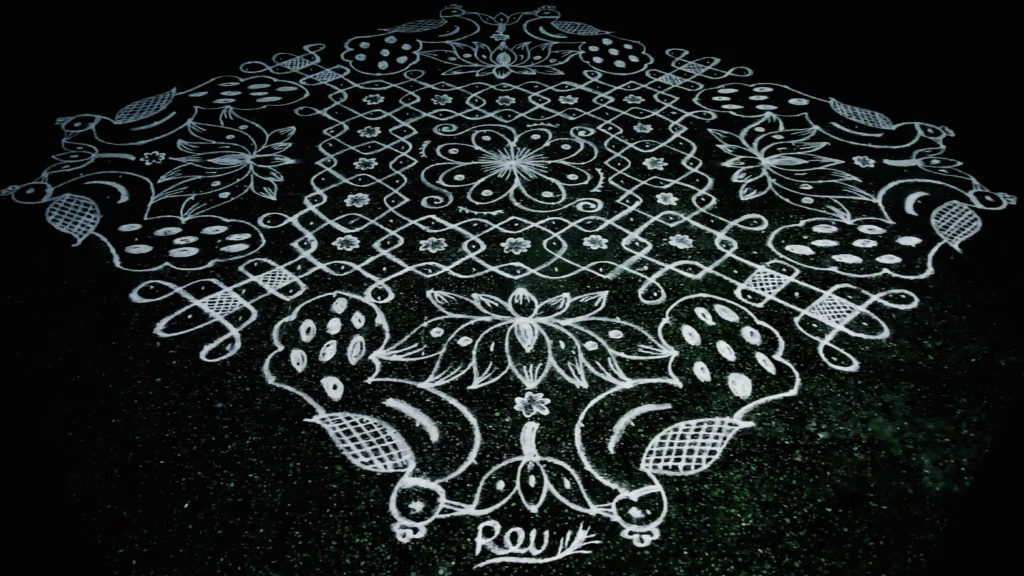
- Swastika
An ancient symbol of well-being and good fortune, the swastika is drawn to invite prosperity and protection into homes. It is a powerful emblem of positivity and blessings. - Geometric Shapes
Patterns made with squares, circles, and triangles are seen as symbols of stability, unity, and harmony. These shapes often form the base of Kolam designs, reflecting a sense of order and balance.
How Is Kolam a Model of Sustainability?
Natural Materials with Purpose
Kolam is made using rice flour, a simple, biodegradable material that is gentle on the earth. In many homes, coarser rice powder is used, serving a dual purpose—it feeds small creatures like ants and birds while adding beauty to daily life. This practice quietly reinforces the idea of coexistence and care for all living beings.
Zero Waste, Maximum Impact
Unlike modern art forms that often rely on synthetic or wasteful materials, This art form leaves no trace behind. The rice powder dissolves into the soil or is consumed by nature’s smallest creatures, creating a natural cycle that leaves the environment untouched and unharmed.
A Daily Ritual of Renewal
Drawing a Kolam each morning isn’t just about creating art; it’s a moment of mindfulness and renewal. It’s a daily act of reconnecting with the earth, reminding us of the importance of simplicity and the beauty of starting afresh every day.
Preserving Tradition and Community
Kolam keeps alive the traditional knowledge and skills passed down through generations. It celebrates the idea of creating beauty with what is readily available, fostering a sense of community and respect for cultural heritage.
The Power of Simplicity
At its heart, Kolam teaches us that art doesn’t have to be complicated or resource-heavy. It proves that with just a handful of rice flour and a steady hand, we can create something beautiful. This simplicity inspires us to look at life differently, valuing minimalism over excess.
What are the methods of Kolam?
Tamil women traditionally draw the beautiful patterns of kōlam using rice flour, stone powder, or colored powders, typically held in a container such as a plastic bowl or a traditional half-coconut shell. There are two primary techniques for creating these designs: the dry-rice-flour method and the wet-rice-flour method.
In the dry-rice-flour method, a pinch of rice flour is picked up using the thumb and held securely against the forefinger. The rice flour is then gently released by pressing the thumb against the forefinger while holding it about an inch above the floor. In rural areas, before starting the kōlam, the ground is carefully swept and dampened with water. Sometimes, a mixture of cow dung and water is applied to the surface before the design is drawn. This combination of cleaning rituals is believed to purify the space, adding a spiritual element to the process.
For special occasions when the kolam needs to last longer, the rice flour is mixed with water to create a paste. A folded piece of cloth, or sometimes a paper towel, is dipped into this rice paste, and placed between the thumb, forefinger, and middle finger. As the fingers press together, drops of the wet rice flour flow out, allowing the artist to draw the kolam, much like using a pen to write. These designs, which are more durable and semi-permanent, are known as mākōlam. The challenge in this method is to maintain a smooth, even flow of rice paste so that the lines appear continuous, and the shapes remain sharp and clear.
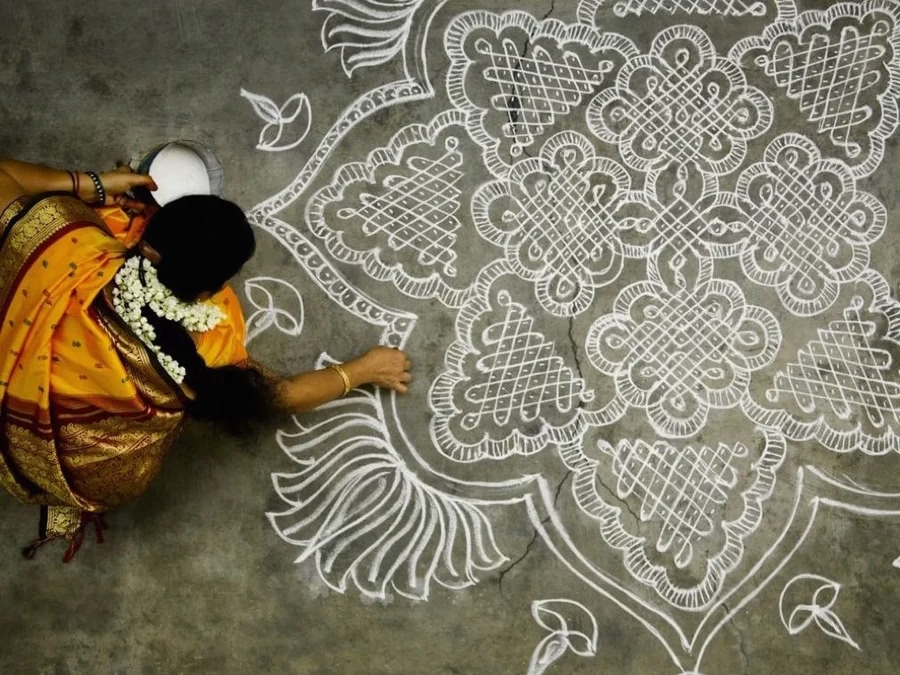
In modern times, when time is limited or space is constrained, many people turn to stencils or rollers made of materials like brass, stainless steel, aluminum, or PVC. These tools are used to stamp out more tangled patterns quickly. Additionally, plastic stick-on decals with pre-designed kōlams have become a popular choice, especially in urban areas. These stickers are often placed on the thresholds of modern apartments, where space is limited, offering an easy alternative to the traditional hand-drawn art.
What are the Designs and Lines in Kolam
Kolam designs come in various styles, blending geometry, nature, and stories. These patterns can be grouped into geometric, figurative, or landscape designs—or a mix of these. At the core of Kolam are simple shapes like circles, triangles, squares, and spirals, each carrying meaning. For example, the six-pointed star, created with interlocking triangles, represents the union of male and female energies.
The base of most Kolams is a grid of dots (pullis), which act as guides. By joining or looping around these dots, beautiful patterns emerge, sometimes symmetrical geometric shapes, and other times flowers, birds, trees, or even depictions of gods and goddesses. Some Kolams include symbolic elements like the sacred pot, conch, lotus, lamps, mirrors, or books, all reflecting tradition and spirituality.
Modern versions sometimes feature airplanes, toys, butterflies, and even characters like Mickey Mouse or Santa Claus, blending traditional art with contemporary themes.
The lines play a key role in bringing these designs to life. Artists use:
- Straight and curved lines
- Open-ended or closed-ended lines
- Vertical, horizontal, zigzag, and wavy lines
These lines can vary in thickness, thin, thick, or even multiple lines, based on the occasion. On regular days, simple two-line designs are common, while special celebrations may call for more elaborate patterns with multiple lines.
What Are the Different Types of Kolam
1. Festivals and Religious Celebrations
Pongal: During the harvest festival of Pongal, celebrated in the month of Margali (mid-December to mid-January), a special Kolam is created around the kitchen stove or chullah. The design often includes figures of Surya (the Sun God), sugarcane, or a sacred vessel called a kalash, symbolizing gratitude for the harvest and marking the beginning of the sun’s northward journey (Uttarayan). Rice powder is typically used for these Kolams.
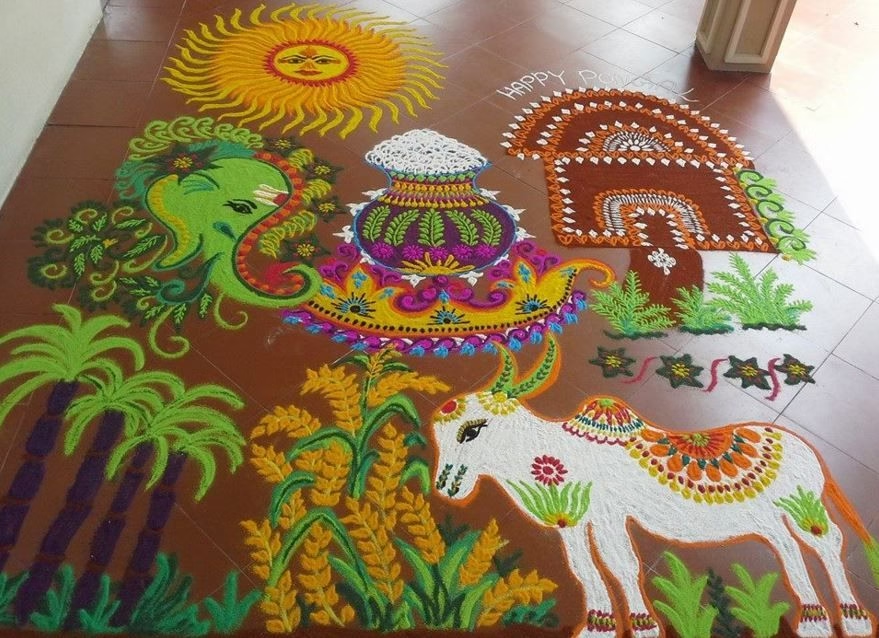
anmashtami/Gokulashtami: On this day, dedicated to celebrating the birth of Lord Krishna, families make a large Kolam at their entrance. Alongside the main design, tiny footprints are drawn, symbolizing the arrival of baby Krishna into the home. Often, another is created in the worship area of the house.
Deepawali: During the festival of lights, Kolams are made with rice powder, along with Kaavi (a brick-red powder) to form borders believed to ward off evil spirits. Designs often include lamps and lotus flowers, symbolizing light, purity, and prosperity.
Sacred Vows: On special occasions such as sacred vows (vrats), Navagraha Kolam are created, specifically in front of household shrines. These are done only on select occasions, as they represent the worship of the nine planets.
2. Family Celebrations
Birth (Thottil Kolam): On the naming ceremony of a newborn, a Kolam is drawn, usually with a bundle of rice placed at its center. A prayer is sung, wishing the child good health and long life.
Marriage (Manai/Kanya Kolam): A special, often large sized art form is made for weddings. Family members work together to create it, with the main design usually laid out by experts. Often made using rice paste, rice powder, Kaavi, and Manjal (turmeric).
13th-Day Ceremony (Kalyana Kolam): On the 13th day following the death of a loved one, a large version is created to mark the completion of mourning. Until the anniversary of the death, no Kolams are made in the house, as it is a period of respect and remembrance.
3. Welcoming and Special Days
On Friday (Padi Kolam): Fridays are sacred for the worship of Goddess Lakshmi, the goddess of wealth and prosperity. On this day, a special Kolam is drawn to invite her blessings into the home.
Welcoming (Nalvaravu Kolam): This is made when welcoming guests, friends, or family, adding a warm, festive touch to any occasion. Designs often feature symbols of prosperity, like the lotus, conch, and lamp.
4. Everyday ones
Chikku/Sikku (Knot or Twisted) Kolam: This design involves curved lines drawn around a central dot, creating a flowing pattern where the beginning and end are hard to distinguish. It represents the endless cycles of life.
Pulli Kolam: The base is formed by placing dots in a grid or matrix. The design is then created around these dots, and it can take on various forms, including Kambi (line) Kolam, Neli (curve) Kolam, Kodu (tesselated) Kolam, Woda Pulli (loop Kolam with hexagonal dots), and Ner Pulli (loop Kolam with square-packed dots).

Each art form, whether for a religious festival, a personal milestone, or an everyday occasion, carries with it a sense of connection—connecting the family with tradition, with the divine, and with the natural world. Every line drawn, every dot placed, is a prayer, an offering, and a reminder of life’s beauty and impermanence.
What is the significance of Kolam?
The ritual of drawing a Kolam carries deep symbolic, cultural, and spiritual significance, with multiple interpretations that reflect the values of Tamil culture. When Tamil women are asked why they perform this daily act, their responses reveal a rich variety of reasons rooted in devotion, tradition, and community.
For many, drawing a Kolam is a way to honor and invite various deities into the home. It is seen as an offering of respect and gratitude to gods such as Bhudevi, who represents the earth and sacred geography; Lakshmi, the goddess of wealth, prosperity, and well-being; Surya, the Sun god, symbolizing health and wisdom; and Ganesha, the remover of obstacles.
Also, the Kolam is believed to fulfill an important daily household duty, one that involves – “feeding a thousand souls,” said Vijaya Nagarajan. It is a sacred act of nurturing and inviting positive energy into the home, nourishing both the human and spiritual aspects of life. This act of feeding is symbolic, offering sustenance to the invisible and sacred energies that surround us.
The ritual also has protective purposes. It is thought that the Kolam helps to ward off evil, particularly the influence of Mūdevī, Lakshmi’s sister, who is associated with misfortune, illness, and laziness. The presence of a Kolam is believed to block the entry of negative forces, while its absence can signal misfortune or a time of mourning, such as the passing of a loved one.
Conversely, the absence of a Kolam during certain times, such as during menstruation or the mourning period following a death, is understood to signify a time of ritual impurity or mourning.
For Tamil Hindu women, being able to create a traditional Kolam in one continuous flow, rather than in pieces, is seen as a demonstration of skill and creativity. This act of drawing is not only a household responsibility but also a reflection of a woman’s role as the caretaker and guardian of the home.
During the sacred Margazhi month, when Kolams are drawn with particular reverence, the competition among women intensifies. It becomes a time of friendly rivalry, with contests held in towns and villages where women showcase their Kolam-making talents. This playful competition is a celebration of creativity, tradition, and the pride women take in maintaining the rituals that define their homes and communities.
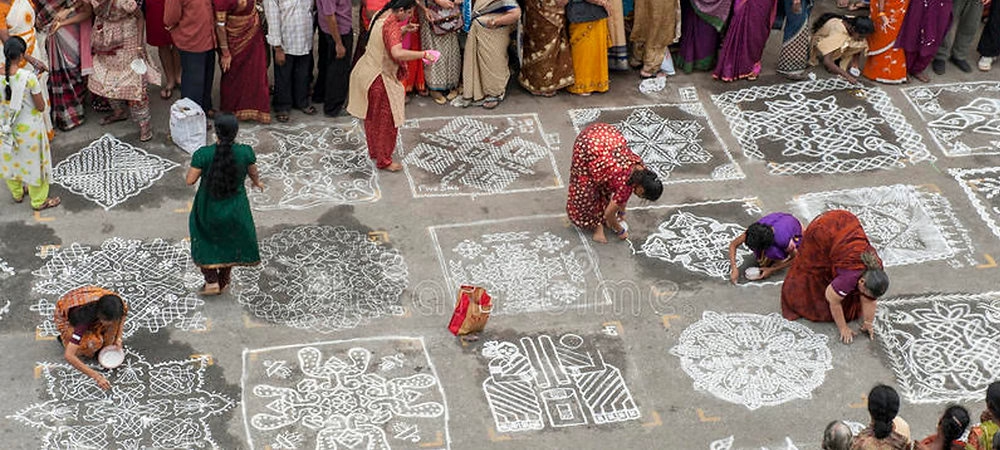
Kolam as a Form of Meditation and Mindfulness
Focus is crucial in our fast-paced world, enabling us to channel our energy and attention towards a specific task. The ancient practice of creating Kolam offers a profound way to cultivate that very focus. Through its rhythmic patterns and intentional movements, this art form encourages mindfulness, drawing attention to each moment and task. Here’s how this art form nurtures concentration and inner clarity:
Emphasis on Precision: Every line, curve, and dot in a Kolam pattern requires careful attention. Whether designing a simple figure or a grand, sweeping arrangement, the process demands precision. Each movement of the hand invites the artist to remain present, to ensure the balance of symmetry. This practice of focusing on the smallest details fosters an ability to concentrate and become deeply aware of the task at hand.
Entering a Flow State: Engaging in the act of creating a Kolam has the power to transport the mind into a state of flow—where time seems to stand still, and the world fades into the background. In this state of full immersion, concentration becomes effortless. The rhythmic repetition of each pattern draws the creator into a deep, focused experience, where their energy is entirely absorbed in the moment.
Mindful Repetition: The repetitive motions involved in drawing Kolam patterns act as a form of meditation, allowing the mind to focus solely on the task at hand. As the design unfolds, thoughts and distractions dissolve, leaving only the present moment. This single-pointed attention helps clear the mind, fostering a peaceful environment where clarity and creativity can flourish.
Heightened Spatial Awareness: Kolam’s geometric designs require a keen understanding of space. As one creates the patterns, there is a constant interplay of lines and angles, helping the individual visualize and map out the shapes in their mind. This practice sharpens spatial awareness, enhancing mental focus and training the mind to think more clearly and logically.
A Calming Influence: The act of drawing in a quiet, serene setting has a soothing effect on the mind. The simplicity of the process, combined with the tranquility of the environment, creates a space where calmness can take root. This serenity not only helps sustain focus but also allows the mind to relax, making it easier to maintain attention on the task at hand. Whether it’s the act of sketching a delicate design or coloring in Rangoli patterns, this creative practice offers a therapeutic reprieve that fosters both concentration and peace.
Kolam, in its various forms, transcends boundaries. Known as Muggulu in Andhra Pradesh and Telangana, Rangoli in Maharashtra, Hase and Rangavali in Karnataka, and Alopana in Bengal, this ancient tradition is more than just an art form. It’s a daily ritual that offers a pathway to mindfulness, a meditative practice that cultivates focus and mental clarity, leaving behind a tangible mark of beauty and intention.
Why Is Kolam Integral to Tamil Women’s Art Traditions?
Kolam is deeply tied to women’s art traditions in Tamil Nadu. Passed down through generations, this art is both a skill and a cultural legacy. From an early age, girls observe and learn the techniques from their mothers and grandmothers, ensuring the continuity of this cultural heritage.
It celebrates the labor, creativity, and resilience of women. It is a space where their artistry and contributions to Tamil culture are honored and preserved.
What Challenges Does Kolam Face Today?
Efforts to Revive
Cultural organizations, artists, and enthusiasts are championing efforts to keep this art form alive. Workshops, exhibitions, and digital platforms have introduced Kolam to younger generations and international audiences. Innovations that blend traditional techniques with contemporary designs have further expanded its appeal.
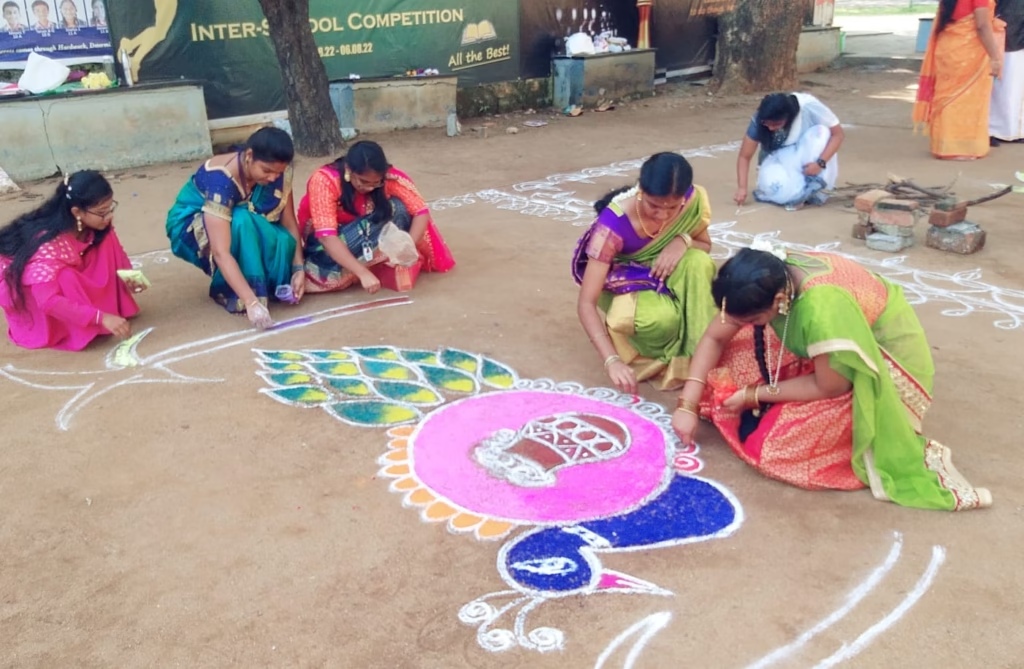
Why Is Kolam Gaining Global Recognition?
Kolam has transcended regional boundaries, gaining recognition on global platforms. It is celebrated in art galleries, cultural festivals, and academic studies, showcasing its artistic depth and cultural richness.
UNESCO’s acknowledgment of Kolam as an intangible cultural heritage underscores its universal appeal and importance as a visual art form that unites people across cultures.
Conclusion – A Living Tradition
This art work is a celebration of Tamil Nadu’s cultural heritage, a testament to its ritualistic art, and a reflection of its sustainable practices. It is an enduring bridge between the sacred and the mundane, the traditional and the modern.
Kolam remains a timeless expression of South Indian art, ensuring that this daily ritual endures as a living canvas of Tamil Nadu’s vibrant culture.
Through the rhythmic sprinkling of rice flour and the creativity of Tamil women, Kolam continues to thrive as a folk art, a visual art, and a way of life. It invites us to appreciate the beauty in simplicity, the wisdom in tradition, and the power of art to connect us to something greater.
In every line and curve, Kolam tells a story—of resilience, creativity, and the eternal dance of life. Its enduring legacy is a reminder of the timeless elegance of South Indian art, ensuring that this daily ritual remains a living symbol of Tamil Nadu’s rich cultural heritage.
______________________________________________________________________________
To explore the vibrant world of art and culture, then visit our FolkCanvas for more exciting content that celebrates the rich world of folk art and creativity.



Leave a Reply